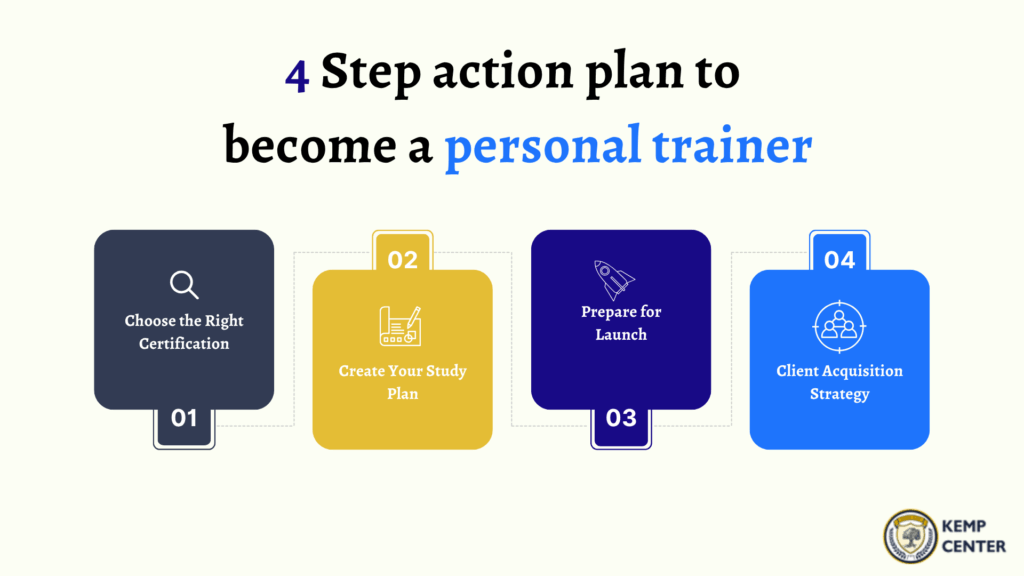Personal Trainer Course - Is It Worth Investing In It?

Table of Contents
Let me know if you recognize this story? It’s Monday morning, your alarm goes off, and you drag yourself to another soul-crushing Zoom meeting, secretly wishing you were coaching someone through squats instead of sitting through spreadsheets. You start to daydream about turning your fitness obsession into a career. But then that annoying voice we all have comes on in your head saying “Is dropping a chunk of change on a personal trainer course actually a smart move?”
We totally get it. Dropping $400 to $2,000 (plus the cost of your growing protein powder addiction) is no small decision. Also, this isn’t just a financial investment, its also time, effort, and a leap of faith in your future. This guide is here to cut through the uncertainty. We’ll take a realistic look at what you can expect from this investment, including earning potential, job flexibility, and how long it might take to see your money back.
The Financial Reality: What Personal Trainers Actually Earn
So, let’s be honest the biggest question on your mind is ““Will this certification pay off?” The short answer? Yes! As long as you approach it like a professional, not a hobbyist.
“According to the U.S. Bureau of Labor Statistics, employment of fitness trainers is projected to grow 10% from 2022 to 2032.”
U.S. Bureau of Labor Statistics – Fitness Trainers and Instructors
Looking at the US market, the average personal trainer makes around $50,000 per year, but the range is wide. As an entry level personal trainer, you are looking to make around $25–$35 per hour. Meanwhile, experienced trainers, especially those in large metro areas or with niche specializations, can command $75 to $100+ per hour.
Being part of the fitness industry for 15 years, I’ve seen certified trainers consistently out-earn their non-certified peers by 40–60%. Specifically, those that specialize in niche areas such as:
- Strength & Conditioning
- Nutrition Coaching
- Sports Performance Training
- Pre/Postnatal Fitness
Certifications act as both a knowledge base and a credibility booster—and clients do care. They’re more likely to pay a premium when they know you have official expertise.
Breaking Down the Investment: Certification Costs vs. Returns
When deciding to become a personal trainer, this is no longer just following your passion but it is also a business decision. So let us help you breakdown upfront costs, long-term value, and how quickly you can expect to see a return.
Popular Certification Programs and Their Costs
Now there are a few things to consider when picking the certificate program right for you. Pay attention to what your goals are, your budget, and how you learn. Here is a table to look and compare at various certification programs cost and how you can expect to earn after completion:
Certification | Cost Range | Average Graduate Salary |
NASM | $599–$1,299 | $52,000/year |
ACE | $599–$999 | $51,000/year |
ISSA | $499–$799 | $48,000/year |
ACSM | $399–$699 | $49,000/year |
Each of these certificates is respected industry wide and offers online options, flexible study timelines, and continuing education opportunities to grow with your career.
Hidden Costs to Consider
Now you need to look beyond the course itself. There are hidden costs associated with starting your personal trainer career. You want to budget for the following things:
- CPR/AED Certification. This is required by most employers and certifying bodies: $75
- Liability Insurance. Essential if you’re training independently or online: $200–$400 annually
- Continuing education and learning options. Required to maintain certification every 1–2 years: $200–$500
- Marketing & Business Setup. Website, branding, scheduling software: $300–$800
Timeline to Profitability
I know that you are wondering how quickly you can go from learning to actually make some money. Here’s a realistic time that might help you out:
- Study & Pass Certification Exam: 3–6 months
- Land Your First Client: 2–8 weeks post-certification
- Replace Full-Time Income: 6–12 months depending on hours, pricing, and niche
Are you curious about the full path to certification? Read our guide on How to Become a Personal Trainer for step-by-step tips.
The Non-Financial Benefits: Why Money Isn’t Everything
So a full wallet of money is important, but many of the best parts of being personal trainer aren’t reflected in your paycheck.
I’ve never met a personal trainer who regretted their career, even those that eventually specialized in gym ownership, physical therapy, or fitness tech. The reason is because this career path offers personal growth, lifestyle freedom, and impact on others are hard to beat.
Here are some things that can be really gained from this career:
- Freedom and flexibility. You can set your own hours, choose your client, and choose where you work. You can work in the gym, online, outdoors, or all three. You are in charge of your schedule, and you are not tied to a desk.
- You get to change people’s lives every day. There is no better feeling than seeing someone hit their first pull-up, regain confidence, or completely transform their health. And this is all thanks to you and that you guided them.
- The fitness industry is constantly evolving, giving you the opportunity to continue to learn. You’ll always have something new to master—whether it’s corrective exercise or nutrition coaching.
- Your own health will improve. When you work in the fitness industry, you are constantly moving, fueling your body, and staying accountable. Your clients won’t be the only ones transforming.
- You will have a real sense of community. The personal training world is filled with passionate, like-minded people who support and inspire one another.
- You can have multiple income streams. You don’t have to limit yourself to 1-on-1 sessions. Many trainers lead group sessions, virtual coaching, social media influencing, workshops, eBooks, and even branded merchandise.
So, you see that the ultimate payoff may be more than just a paycheck, but also in your quality of life. This career lets you build something on your terms, grow as a professional, and leave a lasting impact.
Online vs. Traditional Certification: Which Path Pays Off?
Choosing how you are going to get certified whether online or traditionally is just as important as the certificate itself. Both options can lead you to a successful career in fitness. But, your ideal path depends on your goals, schedule and learning style.
Online Certification Advantages
If you are looking for flexibility in your learning, then online certification may be the right fit for you. People who are career changers and are trying to balance this with a full time job, then to prefer this route.
Some other benefits of online certification include:
- Cost saving. Online programs are typically 20–30% less expensive than in-person alternatives.
- You can learn at your own pace. Study on your own schedule, at your speed. You don’t have to commute or worry about a class schedule.
- You gain access to digital tools. Students who choose online certification gain access to videos, quizzes and interactive modules. Most companies will give you lifetime access.
- This ideal for working adults. You can hold your day job while preparing for a new career on the side.
Traditional Classroom Benefits
On the other hand, if you prefer real-time feedback and practice, then a traditional classroom may be a better fit. In-person courses offer a different kind of value, especially for hands-on learners.
Some key advantages of traditional classroom certificates include:
- You have live practice. You practice cueing, assessing form, and leading sessions with real classmates.
- You get immediate feedback from your instructors. Get your questions answered in the moment, not via email.
- Network with your peers. You can build connections with future colleagues, potential clients and employers.
- There is a fixed structure for progress. Fixed timelines can help with accountability if you struggle with motivation.
Employer Preferences and Market Acceptance
Now, once you are looking to get hired or find clients, the most important aspect is accreditation. No one will really care whether you did the course online or in a traditional classroom setting.
Factor | Online Certification | Traditional Certification |
Gym Hiring Acceptance | Widely accepted (if accredited) | Widely accepted |
Client Perception | Neutral to positive (when explained) | Positive |
Insurance Coverage Eligibility | Fully eligible with NCCA-accredited certs | Fully eligible |
Ongoing Career Support | Often includes lifetime updates, online portals | Often includes alumni networks |
Either path can pay off at the end of the day. What matters most is choosing a format that fits your lifestyle and a certification that opens doors in the real world.
Red Flags: When Personal Trainer Certification Isn’t Worth It
As a personal trainer you can have a lucrative and successful career, but this path isn’t for everyone. Before diving into a certification, it’s important that you have a clear view of the reality of the field.
Now, I’m not trying to scare you off, I just want you to save you time, money, and frustration if your expectations don’t align with the effort required.
Red Flag: Expecting a high income such as $75,000+ in Year One Without Prior Experience
The reality is that most personal trainers need about 3 to 5 years before they get to that level. Many start with part-time clients and work their way up.
Red Flag: You are in a market that is oversaturated with other personal trainers
If you live in an urban area that is flooded with fitness pros, then you need a niche to stand out. Here’s a tip research local job listings, gym hiring needs, and competition in your area before committing.
Red Flag: Sales and Business Skills Not on Your Radar
Being fit and having a certificate is not enough. You’ll need to sell your services, manage clients, and handle scheduling, follow-ups, and payments. This is the reality especially if you are self-employed.
Red Flag: You Can’t Commit Time to Build Your Client Base
Honestly, the reality is that you will need 6 to 12 months to build a client base. If you can train a few hours a few and don’t have time to market yourself, then your progress will be slow.
Red Flag: Choosing a Cheap, Unaccredited Program
If the program isn’t NCCA-accredited, many gyms won’t recognize it. And you may not qualify for liability insurance or continuing education.
Red Flag: Struggling with Reliability or Communication
If you want to be the best trainer it’s not enough to just to be fit. As a personal trainer you need to be punctual, professional, motivating, and a great listener. Your soft skills need to be just as good as your squats.

Your Action Plan: Steps to Maximize Your Investment
You’ve decided that you are going to pursue a certification and career in personal training. It’s time to do it right. To achieve success, you need to do more than just pass an exam. It’s about launching a long lasting and rewarding career.
Here’s your step-by-step action plan to ensure you get the best possible return on your investment—financially and professionally.
Step 1: Choose the Right Certification
You need to start by picking the right certification program for you. You need to pick a certification that is respected, recognized, and relevant to your goals.
- Only consider NCCA-accredited programs like NASM, ACE, ISSA, or KEMP Center
- Make sure to compare costs, support options and study materials
- Align your choice with your target market – whether that be weight loss, strength training, etc.
Step 2: Create Your Study Plan
Creating a study plan is a great way to keep you on track and motivated, while also preventing burnout. Your certificate won’t be of any use to you, if you are burnt out after it’s complete.
Break down your study plan into achievable milestones:
- Choose a realistic timeline based on your availability (average is 12–16 weeks)
- Use study tools such as flash cards, apps, audio lectures and mock exams
- Don’t just memorize, focus on exam strategies. It’s best to understand the material.
A good tip is to schedule your exam ahead of time, having a fixed deadline will help you to move forward.
Step 3: Prepare for Launch
Build momentum sooner rather than later. You don’t have to wait until you’re certified to do this. Start planting the seeds so that they can start to grow.
Here’s a few ways you can build momentum
- Network with local gym owners, other personal trainers, or studio owners
- Set up a professional social media presence and start sharing fitness tips or workouts
- Define your unique value proposition. So you want to be able to tell people: Who do you help, and why are you the right coach?
Another valuable tip for this step is build a simple email list or create a one-page website to collect interest from future clients.
Step 4: Client Acquisition Strategy
Once you a certified, you can shift from studying mode to serving clients. The key is to be consistent in order to build traction. Here are some tips for client acquisition when you are just starting out:
- Use friends, family, and social circles to gain referrals
- Try partnering with local gyms, wellness centers, or rec programs
- Offer free or discounted introduction sessions to build trust and experience. This is a great way to attract clients.
- As you grow collect testimonials to post online and create a digital footprint. Real results and client wins, will build your following.
Honestly, aim to book your first 3–5 clients in the first 60 days post-certification.
Frequently Asked Questions (FAQ)
How long does it take to become a certified personal trainer?
On average most people complete their certification in 3 to 6 months, it depends on the program, study schedule and other life aspects. Online programs offer flexible, self-paced learning that fits around full-time jobs or other commitments.
What’s the average cost of personal trainer certification?
Certification programs typically range from $400 to $1,299, depending on the provider and package. Honestly, you can also expect to invest in other aspects as CPR, insurance and continuing education some time down the line.
Do I need a college degree to become a personal trainer?
No. You don’t need a college degree to become a personal trainer. All you need is a high school diploma or equivalent. And honestly, what matters most is that certificate.
How much can I realistically earn as a new personal trainer?
In the United States, on average new personal trainers can earn around $25–$40/hour, working part-time or in gyms. When you are consistent with your effort and building a client base you are looking to make around $2,000–$4,000/month within your first year.
Is online personal trainer certification as good as in-person?
Yes – if it is accredited. Most major gyms will accept online certificate as long as they are from an accredited program.
What’s the best personal trainer certification for beginners?
For most beginners, NASM, ACE, or ISSA are excellent choices. They offer beginner-friendly content, clear career support, and are widely recognized in the industry. Consider your learning style and goals when choosing.
How do I choose between NASM, ACE, and ISSA?
Here is a breakdown of NASM, ACE and ISSA:
- NASM. This is great for corrective exercise and gym employment
- ACE. This is an excellent choice for general fitness and health coaching
- ISSA. This is ideal for online training and flexibility.
Each of these certificates is respected and is beginner friendly. Make sure to compare pricing, study materials and learn style to pick the right one for you.
Can I become a personal trainer as a side hustle?
Yes. Many trainers start part-time, building their client base around other commitments. This is a great path if you are a fitness enthusiast looking to turn your passion into an income while juggling a day job and other responsibilities.

Summary
Let me tell you how it is, dropping $400–$1,200 on a personal trainer certificate isn’t pocket change. But it’s not a bad deal, I mean think about it. You can earn this back before your protein powder runs out. Most personal trainers hit break-even in 6–12 weeks, and with real hustle, pull in $40K–$80K+ a year (or more, if you go full beast mode with specializations).
Now, this isn’t magic. You can’t just expect to win clients based on a certificate and a gym selfie. In order to be successful, you need a strategy that will help you win clients and be reliable by showing up even on leg day. However, if you are the type of person that would rather coach someone through there last set at the gym than sit through another Zoom call…then this is the path for you.
Bottom line? This career pays off—but only if you show up and put the work in.
Ready to transform your passion for fitness into a profitable career?
Our comprehensive Personal Trainer Certification Program combines industry-leading curriculum with business training and ongoing support. Join thousands of successful graduates who’ve built thriving fitness careers with KEMP Center’s proven system.
